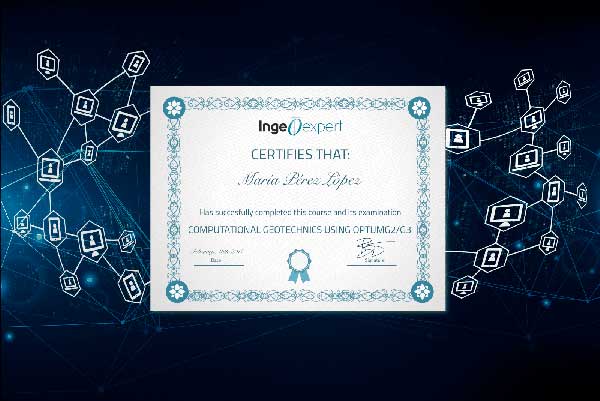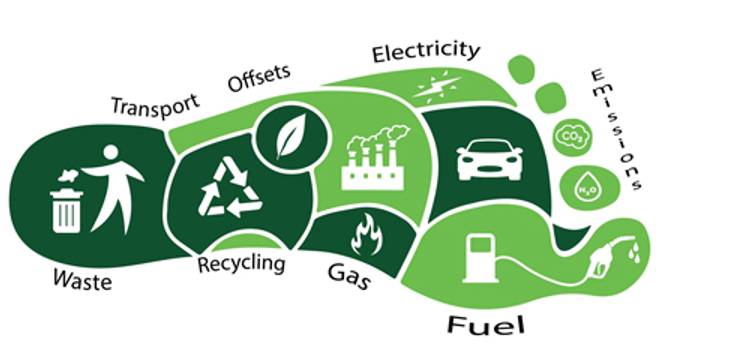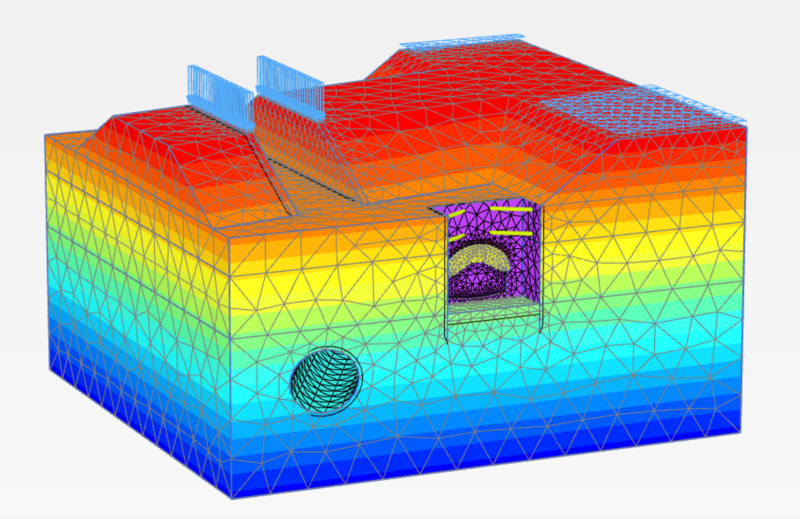Introduction to geotechnical analysis in PLAXIS 2D and 3D
Online course |
|
50 hours / 6 weeks |
|
|
Dates: 28th of October to 9th of December |
| Standard | Unemployed Or Student |
| $346 | $270 |
In colaboration with Bentley Systems

PLAXIS 2D and 3D license included
Get an official certificate provided by Bentley Systems
Introduction
PLAXIS 2D and 3D are some of the world’s favorite software for geotechnical analysis. PLAXIS are user-friendly geotechnical finite element analysis software for engineers to model, simulate, analyze, and deploy geotechnical projects.
PLAXIS features a large range of ground constitutive models and structural elements that allows to model different geotechnical problems, such as:
– Foundations.
– Excavations.
– Diaphragm Walls.
– Tunnelling.
– Embankments.
– Earthquake Analysis.
For this reason, the present course “Introduction to Geotechnical Analysis in PLAXIS 2D and 3D” has been developed to support geotechnical engineers to improve or start a career in geotechnical design and modelling using PLAXIS powerful finite element analysis.
The course is divided into 6 modules and has a duration of approximately 60 hours, covering both Main Geotechnical Analysis both in PLAXIS 2D and 3D and concludes with a Course Final Assessment.
Objectives
The professor, Cláudio Cabral Dias, Head of Ground Engineering and Tunnelling at AYESA, aims to use his extensive international experience in the design and construction of different types of geotechnical structures, to train professional with real projects and didactic exercises, so that they can obtain/improve design skills to work in the dynamic and growing industry of geotechnical analysis.
At the end of this course, you will have the necessary training and basic knowledge to understand:
– Geotechnical Analysis Approaches.
– Constitutive Ground Models.
– Foundations.
– Excavations.
– Diaphragm Walls.
– Tunnelling.
– Embankments.
– Earthquake Analysis.
– Ground Treatment and Groundwater Control.
The course includes at least 3 live webinars to answer questions.
Limited places.
Module 1. Main Geotechnical Analysis (week 1)
- – Geotechnical Analysis Approaches.
- – Constitutive Ground Models.
- – Foundations.
- – Excavations.
- – Diaphragm Walls.
- – Tunnelling.
- – Embankments.
- – Earthquake Analysis.
- – Ground Treatment and Groundwater Control.
Module 2. Introduction to PLAXIS 2D (week 2)
– Introduction to PLAXIS 2D.
– Geology and Stratigraphy.
– Meshing and Initial Stress.
– Axisymmetric Models.
– Field Stress Models.
– Plastic Deformation.
– Constitutive Ground Models.
– Non-Ground Loading and Displacements.
Module 3. Geotechnical Analysis in PLAXIS 2D (week 3)
– Foundations.
– Excavations.
– Diaphragm Walls.
– Conventional Tunnelling.
– Segmental Lining Tunnelling.
– Embankments.
– Earthquake Analysis.
Module 4. Introduction to PLAXIS 3D (week 4)
– Introduction to PLAXIS 3D.
– Geology and Stratigraphy.
– Meshing and Initial Stress.
– Conventional Tunnelling.
– Segmental Lining Tunnelling.
– Ground Treatment and Dewatering.
– Secondary Linings.
Module 5. Geotechnical Analysis in PLAXIS 3D (week 5)
– Circular Shaft.
– Intersection of Tunnel and Shaft.
– Foundations.
– Excavations.
– Diaphragm Walls.
– Embankments.
– Earthquake Analysis.
– Impacts to Existing Assets due to Tunnelling.
Module 6. Final Project (week 6)
–Course Final Assessment.
Cláudio Cabral Dias
Cláudio is a MSc CEng Civil Engineer specialized in Tunnelling with more than 12 years of experience. After working in Portugal, Brazil and UK, he currently resides in Madrid, where he is the Head of the Ground Engineering and Tunnelling design team at AYESA.
His experience includes reference and detailed designs, along with construction supervision of several international underground nuclear, rail, road, and hydroelectric projects in South and North America, UK, Portugal, Spain, and India. His experience includes projects such as the underground of Sao Paulo, Rio de Janeiro, Brasilia, Los Angeles, London, Madrid, and Porto Metros. He is a Bentley Qualified Trainer – PLAXIS FE and an expert in numerical modelling of Soil-Structure-Interaction for tunnelling and excavations.
Cláudio is a member of ITACUS, Portuguese Order of Engineers, certified as EUR ING by FEANI, and CEng MICE by ICE. He has also published more than a dozen papers in conferences and journals, promoting more efficient designs through advanced modelling.
The course is delivered online through our easy-to-use Virtual Campus platform. For this course, a variety of content is provided including:
– eLearning materials
– Videos
– Interactive multimedia content
– Live webinar classes
– Texts and technical articles
– Case studies
– Assignments and evaluation exercises
Students can download the materials and work through the course at their own pace.
We regularly update this course to ensure the latest news and state-of-the-art developments are covered, and your knowledge of the subject is current.
Live webinars form part of our course delivery. These allow students and tutors to go through the course materials, exchange ideas and knowledge, and solve problems together in a virtual classroom setting. Students can also make use of the platform’s forum, a meeting point to interact with tutors and other students.
The tutoring system is managed by email. Students can email the tutor with any questions about the course and the tutor will be happy to help.
The course is especially useful for students or professionals in the following areas:
- – Civil Engineers
- – Geotechnical Engineers
- – Geologists
- – Geological Engineers
- – Mining Engineers
Once a student finishes the course and successfully completes the assignments and evaluation tests, they are sent an accreditation certificate. The certificate is issued by Ingeoexpert to verify that the student has passed the course. It is a digital certificate that is unique and tamper-proof – it is protected by Blockchain technology. This means it is possible for anyone to check that it is an authentic, original document.
You will be able to download the certificate in an electronic format from the Virtual Campus platform. The certificate can be forwarded by email, shared on social networks, and embedded on websites. To see an example, click here.
This course will enable you to develop or enhance your geotechnical modelling and analysis skills using PLAXIS 2D and 3D. Using PLAXIS for geotechnical analysis is a skill increasingly required by the geotechnical industry and becoming more experienced and skilled will enable you to progress further in applying for a new position or gaining promotion to a more senior role as a geotechnical engineer.
In colaboration with Bentley Systems



PLAXIS 2D and 3D license included
Get an official certificate provided by Bentley Systems
Introduction
PLAXIS 2D and 3D are some of the world’s favorite software for geotechnical analysis. PLAXIS are user-friendly geotechnical finite element analysis software for engineers to model, simulate, analyze, and deploy geotechnical projects.
PLAXIS features a large range of ground constitutive models and structural elements that allows to model different geotechnical problems, such as:
– Foundations.
– Excavations.
– Diaphragm Walls.
– Tunnelling.
– Embankments.
– Earthquake Analysis.
For this reason, the present course “Introduction to Geotechnical Analysis in PLAXIS 2D and 3D” has been developed to support geotechnical engineers to improve or start a career in geotechnical design and modelling using PLAXIS powerful finite element analysis.
The course is divided into 6 modules and has a duration of approximately 60 hours, covering both Main Geotechnical Analysis both in PLAXIS 2D and 3D and concludes with a Course Final Assessment.
Objectives
The professor, Cláudio Cabral Dias, Head of Ground Engineering and Tunnelling at AYESA, aims to use his extensive international experience in the design and construction of different types of geotechnical structures, to train professional with real projects and didactic exercises, so that they can obtain/improve design skills to work in the dynamic and growing industry of geotechnical analysis.
At the end of this course, you will have the necessary training and basic knowledge to understand:
– Geotechnical Analysis Approaches.
– Constitutive Ground Models.
– Foundations.
– Excavations.
– Diaphragm Walls.
– Tunnelling.
– Embankments.
– Earthquake Analysis.
– Ground Treatment and Groundwater Control.
The course includes at least 3 live webinars to answer questions.
Limited places.
Module 1. Main Geotechnical Analysis (week 1)
- – Geotechnical Analysis Approaches.
- – Constitutive Ground Models.
- – Foundations.
- – Excavations.
- – Diaphragm Walls.
- – Tunnelling.
- – Embankments.
- – Earthquake Analysis.
- – Ground Treatment and Groundwater Control.
Module 2. Introduction to PLAXIS 2D (week 2)
– Introduction to PLAXIS 2D.
– Geology and Stratigraphy.
– Meshing and Initial Stress.
– Axisymmetric Models.
– Field Stress Models.
– Plastic Deformation.
– Constitutive Ground Models.
– Non-Ground Loading and Displacements.
Module 3. Geotechnical Analysis in PLAXIS 2D (week 3)
– Foundations.
– Excavations.
– Diaphragm Walls.
– Conventional Tunnelling.
– Segmental Lining Tunnelling.
– Embankments.
– Earthquake Analysis.
Module 4. Introduction to PLAXIS 3D (week 4)
– Introduction to PLAXIS 3D.
– Geology and Stratigraphy.
– Meshing and Initial Stress.
– Conventional Tunnelling.
– Segmental Lining Tunnelling.
– Ground Treatment and Dewatering.
– Secondary Linings.
Module 5. Geotechnical Analysis in PLAXIS 3D (week 5)
– Circular Shaft.
– Intersection of Tunnel and Shaft.
– Foundations.
– Excavations.
– Diaphragm Walls.
– Embankments.
– Earthquake Analysis.
– Impacts to Existing Assets due to Tunnelling.
Module 6. Final Project (week 6)
–Course Final Assessment.
Cláudio Cabral Dias
Cláudio is a MSc CEng Civil Engineer specialized in Tunnelling with more than 12 years of experience. After working in Portugal, Brazil and UK, he currently resides in Madrid, where he is the Head of the Ground Engineering and Tunnelling design team at AYESA.
His experience includes reference and detailed designs, along with construction supervision of several international underground nuclear, rail, road, and hydroelectric projects in South and North America, UK, Portugal, Spain, and India. His experience includes projects such as the underground of Sao Paulo, Rio de Janeiro, Brasilia, Los Angeles, London, Madrid, and Porto Metros. He is a Bentley Qualified Trainer – PLAXIS FE and an expert in numerical modelling of Soil-Structure-Interaction for tunnelling and excavations.
Cláudio is a member of ITACUS, Portuguese Order of Engineers, certified as EUR ING by FEANI, and CEng MICE by ICE. He has also published more than a dozen papers in conferences and journals, promoting more efficient designs through advanced modelling.
The course is delivered online through our easy-to-use Virtual Campus platform. For this course, a variety of content is provided including:
– eLearning materials
– Videos
– Interactive multimedia content
– Live webinar classes
– Texts and technical articles
– Case studies
– Assignments and evaluation exercises
Students can download the materials and work through the course at their own pace.
We regularly update this course to ensure the latest news and state-of-the-art developments are covered, and your knowledge of the subject is current.
Live webinars form part of our course delivery. These allow students and tutors to go through the course materials, exchange ideas and knowledge, and solve problems together in a virtual classroom setting. Students can also make use of the platform’s forum, a meeting point to interact with tutors and other students.
The tutoring system is managed by email. Students can email the tutor with any questions about the course and the tutor will be happy to help.
The course is especially useful for students or professionals in the following areas:
- – Civil Engineers
- – Geotechnical Engineers
- – Geologists
- – Geological Engineers
- – Mining Engineers
Once a student finishes the course and successfully completes the assignments and evaluation tests, they are sent an accreditation certificate. The certificate is issued by Ingeoexpert to verify that the student has passed the course. It is a digital certificate that is unique and tamper-proof – it is protected by Blockchain technology. This means it is possible for anyone to check that it is an authentic, original document.
You will be able to download the certificate in an electronic format from the Virtual Campus platform. The certificate can be forwarded by email, shared on social networks, and embedded on websites. To see an example, click here.
This course will enable you to develop or enhance your geotechnical modelling and analysis skills using PLAXIS 2D and 3D. Using PLAXIS for geotechnical analysis is a skill increasingly required by the geotechnical industry and becoming more experienced and skilled will enable you to progress further in applying for a new position or gaining promotion to a more senior role as a geotechnical engineer.
More info
Finish this course and get a certificate based on Blockchain
Introduction to geotechnical analysis in PLAXIS 2D and 3D


Blockchain technology makes the certificate incorruptible, enabling companies to verifiy its autenticity.
Introduction to geotechnical analysis in PLAXIS 2D and 3D
| $346 | $270 | |
| Get more information |





Reviews
There are no reviews yet.